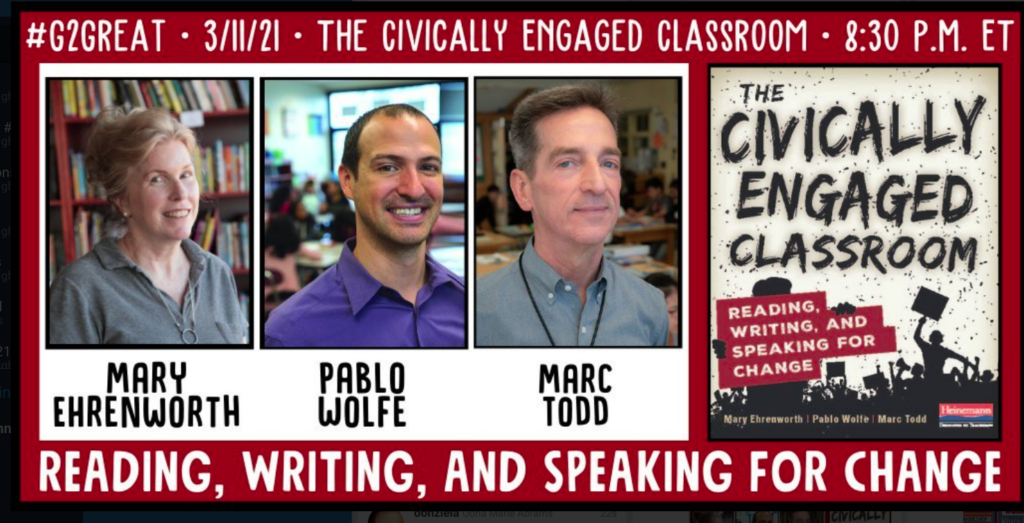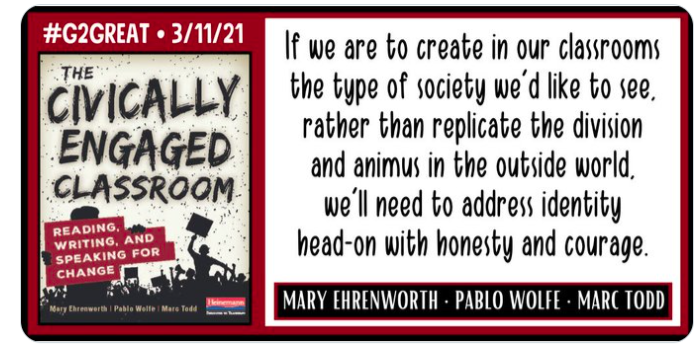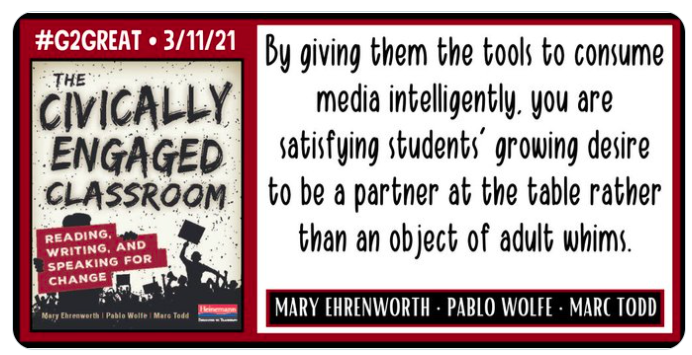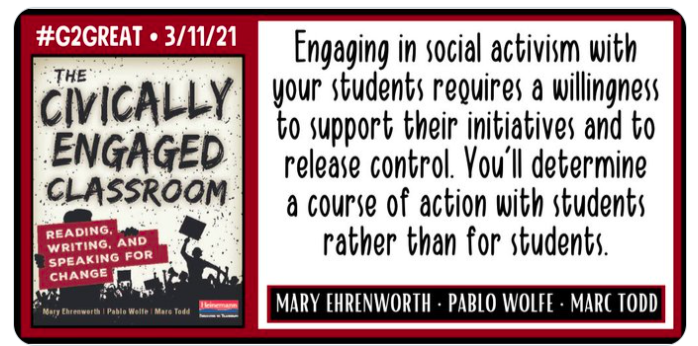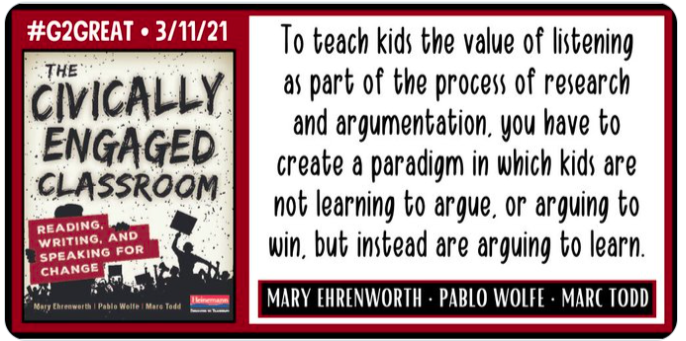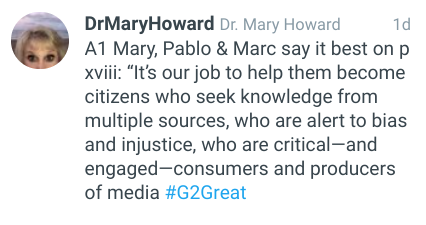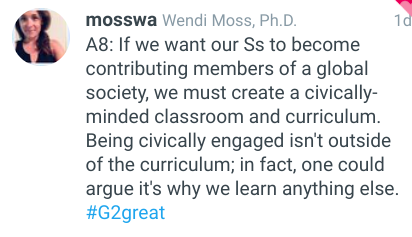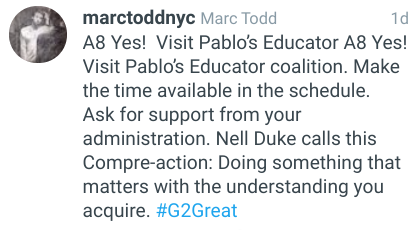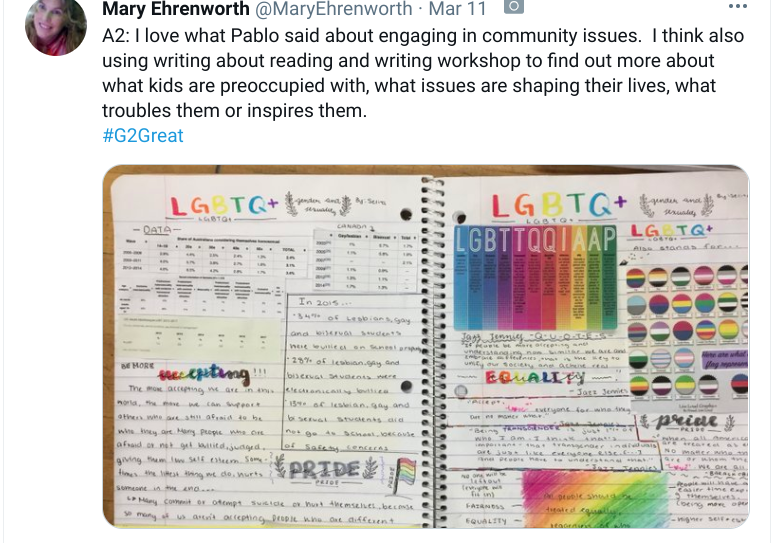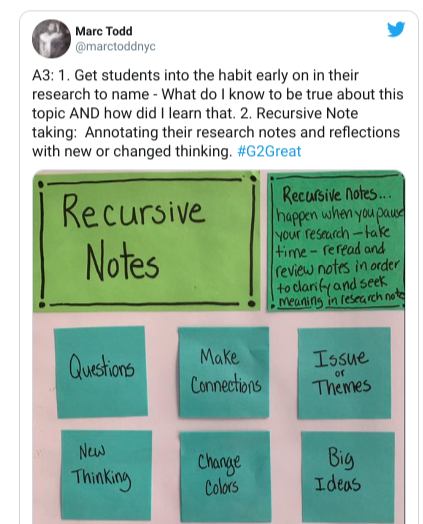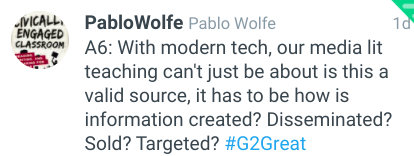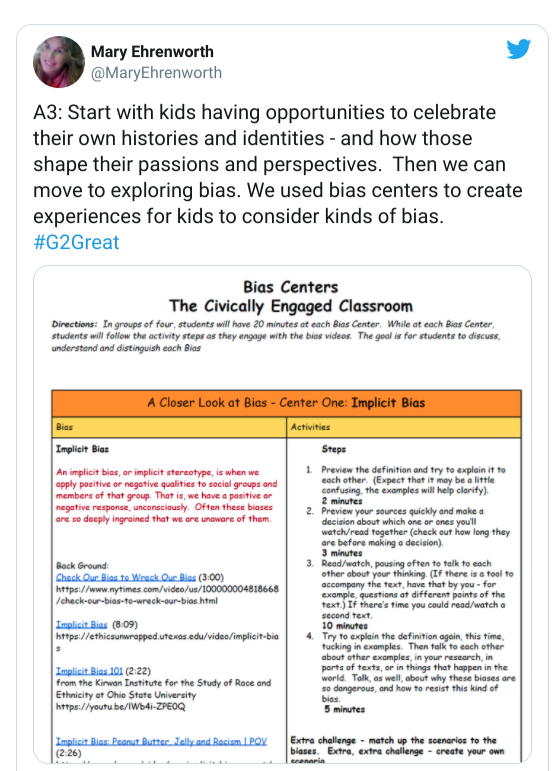By Fran McVeigh
The Wakelet artifact is available for your perusal here.
The #G2Great chat world was alive, well, and ROCKING on Thursday, March 11, 2021. The podcasts (link) of their work was a hint of the depth of the work proposed but, WOW! What an amazing, well-orchestrated text and chat.
On one hand, when a book comes from authors like Mary Ehrenworth, Pablo Wolfe, and Marc Todd, it might be easy to say “Oh, great, another book about what kids can do in classrooms with supportive teachers, supportive administrators and supportive communities.” However, the wisdom, wit, and enthusiasm generated in the #G2Great chat merely emphasized that everyone in school communities needs to be thinking about civic engagement. Not just one class period a day. Not just the ELA teacher. Not just teachers. But the entire community. (And more about that later.)
On the other hand, naysayers may have a different view. “Really? More political speak about what teachers should or should not be doing in their classrooms? More brainwashing? Is that really the purview of our school systems?
Like any great performance from an orchestra, the resulting concert is only as good as the score. In this case, the score (written music) begins this post with the wisdom of the authors and their responses to the three questions that we ask and then moves to some specific high notes from the chat and then enthusiasm as a rousing finale for this work.
1) What motivated you to write this book? What impact did you hope that it would have in the professional world?
The Civically Engaged Classroom was born out of the idea that as a society we need to think deeply about the purpose of school, especially in times as fraught and divisive as those we are living in. We want teachers to look at their classrooms and see future citizens in front of them, citizens that need to be well-prepared for the hard work of leading and strengthening our democracy.
In our own teaching and staff development, we have met many colleagues who have inspired us with the way they teach with a civic mindset. We have also met countless others who aspire to do this work, but are in communities where they feel unsupported. This book is meant to both highlight the brilliant work we’ve seen, as well as to encourage, inspire and sustain those who feel like they’re teaching into a headwind.
We were also motivated to write this book because it helps to address one of the persistent questions in education: how do we get kids motivated and engaged by school? We think one of the most profound, and overlooked, ways to engage kids is to make sure that the work of school is aimed toward civic ends. When the walls of the classroom come down, kids see that their work has real purpose and impact.
Ultimately, as with everything in education, this is for the kids. We hope that some of what we put in the book helps them seize their power and shape the world they will inherit.
2) What are your BIG takeaways from your book that you hope teachers will embrace in their teaching practices?
We hope that our readers see…
● …that identity exploration is essential to all curriculum and pedagogy, especially if we are to prepare our children to engage responsibly in our multicultural society.
● …that schoolwork must be worldwork. That it should include political and historical content that is relevant and contemporary.
● …that we need to move beyond the single text, everytime, in every situation.
● …that we can model being active, engaged citizens in front of our students without being partisan.
● …that when students consume nonfiction, they must teach each other and their parents about what they are learning and why it matters.
● …students need frequent opportunities to practice service to a community.
● …that teachers aren’t alone in this work! There is a thriving, and growing, number of us who are re-envisioning school as a preparation space for citizenship.
3) What is a message from the heart you would like for every teacher to keep in mind?
This book is a call to work. Throughout The Civically Engaged Classroom we’ve included a feature called Practice What You Teach, a regular reminder that the work in these pages is for all of us to take on, not just our kids. We can all do more to be better citizens; we can all do more to re-envision our democracy. This is not about indoctrinating children, but it is about our duty as educators to help them realize that they have a lot of responsibility in this society and that if they don’t take it, or aren’t adequately prepared for it, they’ll continue to perpetuate grievous harms to themselves and to others.
The work in our classrooms is part of the world. The more we bring the real world in with its injustices as well as its beauty and hope, the better we serve our students, and the better we serve our society.
Ultimate Roles For Teachers and Students
What is needed? Teachers who address identity with honesty and courage, … co-creating with students on a level playing field … to determine a course of action with students … valuing listening and … arguing to listen. Check out the following four tweets that include Mary, Pablo and Marc’s own words.
What is the end goal? Dr. Mary Howard gives us the “411”straight from the book:
While it may seem “easy” to defer to the authors to use their own words, this post could become quite lengthy if a commentary was included for all their wisdom. So sticking with a personal motto of “less is more” here are three high notes of focus from the chat. These refrains will help you get started on a civically engaged classroom.
Where and How Does a Civically Engaged Classroom Fit?
Where do you position a civically engaged classroom? Do you view it as a solo? As an entire section of the performers? Or embedded in the entire musical performance? Your view impacts your planning. Consider these gems of wisdom.
Where might you begin? What do you value? What are your priorities? And then consider Pablo’s wisdom and his verb choices . . . “cut” . . . “replace” . . . “OR infuse” with the end goals of “application of skills, real-life experience, and communal celebration.”
Students: Identity, Stories, Experiences and Interests
The work of so many “artists/performers/authors” is the foundation for all work with students. Sara Ahmed’s identity work in Being the Change (blog post) has led the way for teachers and students to explore their identity and bring about social change. So too have Jody Carrington in Kids These Days and more recently Matt Kay in Not Light, But Fire as well as many other authors. When we embrace Dr. Rudine Sim Bishop’s, “windows, mirrors, and sliding glass doors,” we will have a fun-filled concert program as we follow the lead of so many educators when we consider how to engage students by following their interests.
Where can you find the information to get started? What do you already know about your students? Their interests? Their passions? What are the artifacts that they already have about their own thinking beyond what they are reading and writing? How are we inviting students to be a part of this co-construction?
Explicit Instruction: Norms, “Inclusion,” Note-Taking, and Examining Biases
But what do we teach? What’s important? Of course instruction will vary depending on the needs and interests of the students in front of you! Here are a few ideas for you to consider as you wonder about the WHAT that needs to be taught and practiced before the concert is scheduled.
Instruction is all about routines and processes. Routines and processes for civil discourse. Routines and processes for research. Routines and processes for affirming information. Routines and processed for determining biases and collecting additional information. Which ones might be a priority for you and your students?
FINALE
In conclusion, the time for action is NOW. No waiting. Do not pass go. Do NOT collect $200. Move from the audience to the stage, backstage, behind the side curtains, or center stage under the lights.
It’s time to practice. Take action. Consider student identities. Have a discussion. Focus on student choices. To learn more, check out the Wakelet archive and the Additional Resources. Watch the stellar three part video series. Check out the Coalition of Civically Engaged Educators below. Explore the padlet. Find a friend to travel this journey together and have a conversation partner. Make a plan. Get started!
Additional Resources:
Heinemann Video Series for the Civically Engaged Classroom
The Coalition of Civically Engaged Educators
The Civically Engaged Classroom PADLET
Nurturing Truth-Seeking Communities in School (article by Pablo, Mary and Marc)
